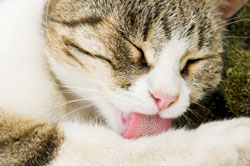Why Cats' Tongues Are Rough

As you may have noticed if kitty ever grooms you accidentally or on purpose, cats have very coarse tongues. Cats’ tongues are covered with backward-pointing spikes called papilla. That’s why your cat’s tongue feels like sandpaper when it’s rubbing against you; all those little hooks are tugging at your skin.
Cats’ Tongues are Eating Utensils
Cats use their tongues’ abrasiveness to scrape meat off the bones of their prey. In the wild, that may be the most vital role played by cats’ rough tongues. But it is far from their only function.
Cats’ Tongues are Brushes and De-tanglers . . .
Cats’ barbed tongues are also essential grooming tools. When grooming, cats use their tongues to moisten the fur with saliva which keeps the fur clean and smelling fresh and helps to regulate body temperature. The barbs on their tongues grab and remove lose fur and debris and aid in detangling mats.
. . . But You Can Assist with Those Chores
Since the barbs on cats’ tongues point inward and are designed to grab and pull material, it’s difficult-to-impossible for cats to spit out loose hair that they pull off with their tongues during grooming. They end up ingesting it. That’s how they get hairballs–their anatomy forces them to swallow hair snagged by their tongues, and for many cats not all of the swallowed hair passes through their systems, so they cough it up as hairballs. Frequent combing—especially on longhair breeds—can get rid of a lot that extra fur that would end up in kitty’s mouth, and is an excellent first defense against hairballs. (Note that this preventive step is important even if your cat does not cough up hairballs; ingested fur sometimes accumulates in cats’ intestines, causing serious problems.)
String is Dangerous Once Caught by Cats’ One-Way Tongues
Keep string-like household objects, such as yarn, dental floss, and ribbons, out of kitty’s reach. In addition, only let your cat play with toys that have strings while under responsible human supervision, and after each play session put those types of toys away where your cat can’t get at them. The danger again is the directionality of cats’ tongues. Because of their backward-facing barbs, cats’ tongues are designed for intake only; this means that once the string is caught by your cat’s tongue, it’s likely to be swallowed; your cat doesn’t have much choice.
Cats’ Tongues are Drinking Utensils
Cats form their tongues into small cup shapes when they lap up water. Cats’ taste buds, also located on the tongue, are sensitive to the taste of water, so make sure kitty always has clean, fresh water.
You May Also Like These Articles:
Does Your Cat Have Whisker Fatigue?
Why Do Cats Purr? The How & Why of Cat Purring
Should You Get Your Cat a Water Fountain?



